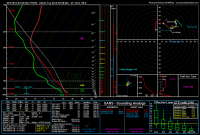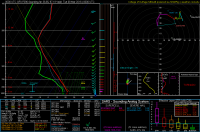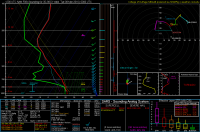James Gustina
Supporter
We're still currently sitting just outside of NAM and other medium-range models, but getting the ball rolling on the recent consistency of the GFS and ECM is a good start.
Per the latest 12Z run of the GFS, a lead impulse is progged to enter the southern Great Plains around the late morning on Monday ahead of a much larger longwave that will still be off the western coast of California by late Monday. Moisture return has been the main sticking point so far, with generally varying solutions on the degree of moisture return between the NAM and GFS by Sunday. A weak baroclinic zone situated southwest of SPS appears to stunt return flow over the weekend but has gradually been removed by the NAM while still being present in the 12Z GFS. Mid-50 dewpoints appear to be likely but beyond that is still in free fall and we've still got about two more days before we'll get an actual idea of the kind of fetch we have.
Even with moisture depth and northward limit is still in free fall, a sharp dryline has been consistently appearing to begin the day just east of the state line and sharpen as it traipses east. Slightly backing sfc winds ahead of the dryline coupled with MLCAPE values from 1250-1500 j/kg have been consistent along the dryline from Chickasha through Wichita Falls along the moist axis. While the overall shear profile seems ok, some VBV has been showing up in previous runs and may make things a bit harder. Rapid WAA at 850 mb with the slight SW turn to the 850 winds might introduce some capping issues but nothing has shown up as thermonuclear yet.
All in all, nice to see something with the possibility of putting out some isolated storms on the horizon but what exactly we're looking at all appears to still be in free-fall relative to moisture return and how our vertical shear profile shakes out.
Per the latest 12Z run of the GFS, a lead impulse is progged to enter the southern Great Plains around the late morning on Monday ahead of a much larger longwave that will still be off the western coast of California by late Monday. Moisture return has been the main sticking point so far, with generally varying solutions on the degree of moisture return between the NAM and GFS by Sunday. A weak baroclinic zone situated southwest of SPS appears to stunt return flow over the weekend but has gradually been removed by the NAM while still being present in the 12Z GFS. Mid-50 dewpoints appear to be likely but beyond that is still in free fall and we've still got about two more days before we'll get an actual idea of the kind of fetch we have.
Even with moisture depth and northward limit is still in free fall, a sharp dryline has been consistently appearing to begin the day just east of the state line and sharpen as it traipses east. Slightly backing sfc winds ahead of the dryline coupled with MLCAPE values from 1250-1500 j/kg have been consistent along the dryline from Chickasha through Wichita Falls along the moist axis. While the overall shear profile seems ok, some VBV has been showing up in previous runs and may make things a bit harder. Rapid WAA at 850 mb with the slight SW turn to the 850 winds might introduce some capping issues but nothing has shown up as thermonuclear yet.
All in all, nice to see something with the possibility of putting out some isolated storms on the horizon but what exactly we're looking at all appears to still be in free-fall relative to moisture return and how our vertical shear profile shakes out.



